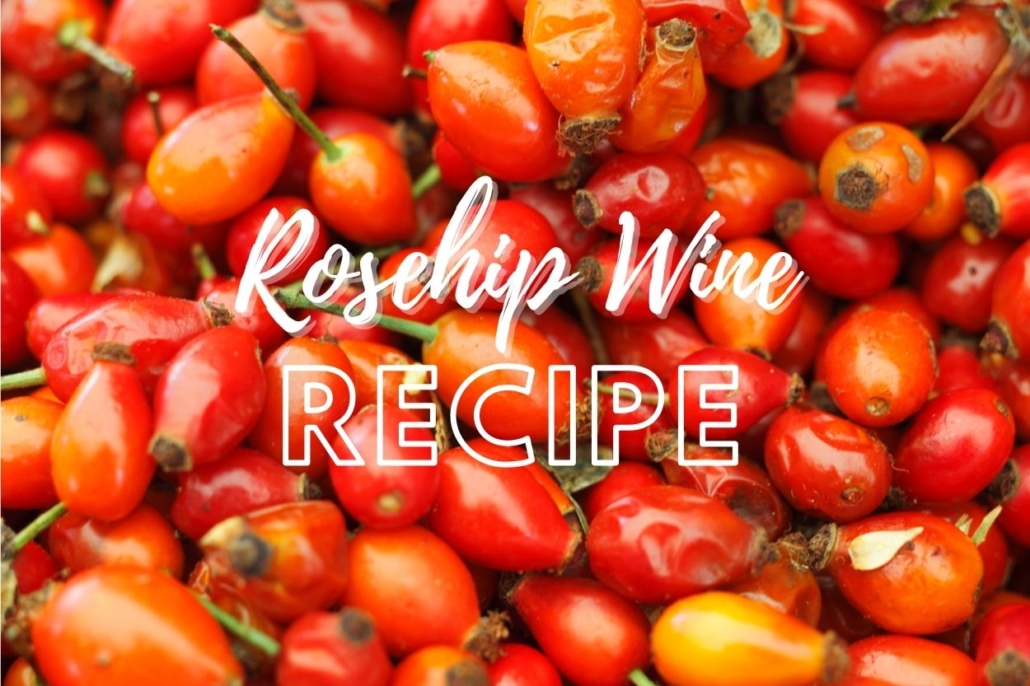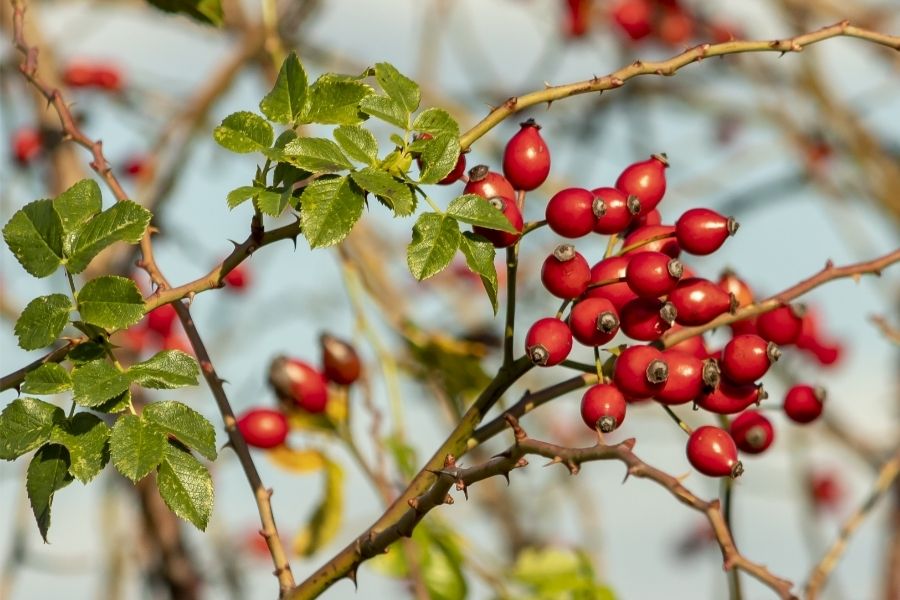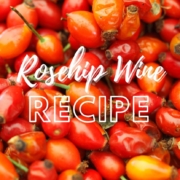Rosehip Wine Recipe – Wild, Delicate Rose Wine

Rosehips are the fruit of the rose plant and although they are bright red and full of hairy pips which need to be removed they are edible (or drinkable). Rosehip wine is one of the best country wines especially in the range of fruits that make a lighter coloured wine.
Table of Contents
What Are Rosehips?
Rosehips, which are also referred to as rose haws are the fruit of the rose plant. If you grow roses you will notice the bulbous, oval hips that form after the bush flowers. Ornamental roses are often selected for not just the flower but the rosehips which may be larger than usual or uniquely coloured.
Rosehips on wild roses or dog roses are bright red and oval-shaped and these can be found in hedgerows, scrubland and growing freely in wild spaces.
I live in an area where I can easily pick enough wild growing rose hips to make wine but if you don’t you can still make the wine with dried rosehips that you can buy online or from health food shops.
When To Pick Rosehips

You want to wait to the rosehips are peaking in ripeness. They should be bright red or deep orange, if they aren’t then they aren’t ripe enough.
They should also be supple with a little give, if you wait till after the first frost they may be too soft and mushy.
What To Expect From Rosehip Wine?
Rosehip wine is a pinkish, amber colour and has quite a lot of tannin. I like to sweeten the finished wine slightly and you get a fuller, rounder flavour that doesn’t need to be conditioned for years before drinking.
Roses are part of the same family as apples and it is fair to say that rosehip wine is reminiscent of apple wine, although slightly more delicate. There is not so much of the scent of rose but a crispness that is quite nice.
Take Care When Picking Rosehips
If you are picking the rosehips yourself you first need to take care that you have correctly identified them. I like to keep an eye out early in the year to see when the roses are in flower and note down the locations of good rose bushes.
The other thing you need to be aware of is if the roses have been treated for any reason. In hedgerows and wild areas this is not a problem but in parks, the plants are sometimes treated with pesticides so these should be avoided.
Preparing Rose Hips To Make Wine
The easiest way to prepare rose hips for making wine is to take the simplest steps.
I like to remove the woody end of the rosehip and as much as the stalk as possible. Once this is done give all the hips a good rinse and remove any mushy or bad rose hips.
Dry them off and then freeze all of the rosehip. Freezing will break down the structure of the rosehips and allow the wine yeast to ferment them and break down the hips even further.
With regards to the seeds inside the rosehip, some suggest removing them, others not. I keep them whole, they will be removed after primary fermentation anyway and they provide a nice amount of tannins that give the wine body.
Using Dried Rosehips To Make Wine
You may choose to substitute dried rosehips for some or all of the fruit if you cannot find a wild-growing rosehip.
If you want to use dried rosehips you need to use approximately a quarter of the weight in dried hips compared to fresh ones. Instead of using 1000g of fresh hips you would use 250g of dried rosehip.
What You’ll Need To Make Rosehip Wine – Makes 1 gallon / 4.5 litres
- Large Stock Pot
- Small Fermenting Bucket
- Demijohn
- Syphon
- Fine Straining Bag
- Potato Masher
- Airlock & Bung
Rosehip Wine Ingredients
- 1kg Rosehips (fresh) or 250g Dried rosehips
- 4.5 litres Water
- 1.1kg Sugar
- 1/2 tsp Acid Blend
- 1 tsp Pectic Enzyme
- 1 tsp Yeast Nutrient
- 1 Campden Tablet
- 1 Sachet Wine Yeast (Lallemand EC-1118 is a good choice but experiment with others)
To start the rosehip wine take the thawed rosehips and place them in the straining bag at the bottom of the sanitised fermenter. Use a masher to press the rosehips and start to break them up. Secure the straining bag to contain the rosehips.
If you are using dried rosehips, secure them in the straining bag.
In the large stockpot, heat half of the water and add all the sugar. Bring to a boil whilst stirring to dissolve all the sugar. Simmer for a few minutes before pouring the boiling water over the fruit in the fermenting vessel.
Add the remaining water to bring the temperature down, add the Campden tablet and then cover and let it sit for 24 hours.
The following day, add the pectic enzyme, acid, yeast nutrient and stir with a sanitised spoon. Take a hydrometer reading to work out the starting gravity. Add the yeast by sprinkling onto the surface of the wine must, then cover and attach an airlock to the lid.
After a week remove the straining bag and let it drain as much liquid as possible. Cover the fermenter again and allow to settle for 1 or 2 days.
After a couple of days rack the rosehip wine to a sanitised demijohn. Seal with a bung and airlock. Allow to condition in the demijohn for at least three months by which time the wine will have cleared or begun to clear. If any sediment builds up, rack the wine to a clean demijohn one or two times. Take a hydrometer reading if you want to accurately calculate the ABV
After 3 months or up to 6 months, you can bottle the wine. If you want to back sweeten the wine which I like to do read this guide on stabilising and back sweetening. Bottle the wine and leave for as long as you can bear. At least another 3 – 6 months but the wine will peak after a year.




I’m new to wine making and would love to try this as my first mead is maturing for the next month or so. Had a sneaky taste of the JOAM recipe I followed, while I was racking it after a month in primary, and it’s looking (or tasting, rather) very good indeed even though it’s still quite young. I’d like to get going on another recipe and your rosehip wine sounds interesting. If i’m using dried rosehips can I simply bag them, place them in the bucket with the sugar and pour boiling water over them? Allow them to brew like a tea for a while then top it up with cold water before adding the campden tablet then proceed as normal?
That sounds great. I would leave the dried rosehips in the wine for around 5 days to extract the most flavor.
You could also think about adding some other fruit to compliment the rosehips if you like. 100 grams of chopped raisins would boost the body of the wine or you could even think of adding berries to the wine along with the rosehips.
Thank you Neil. Just purchased some straining bags for the rosehips and can certainly add in some raisins or wine tannin.
My wife loves this stuff! A friend of hers had a bottle last summer and she has been talking about it ever since, think I might try to make her some. Thanks for the tips.
Hi Neil, recently started this and so far so good, just getting ready to put into the demi-john for the first time. Do you have any suggestions for what to use for topping-up? I have some natural apple juice in fridge, would that work?
Great site, by the way!
It would work as long as there are no preservatives in the juice. Sounds great;